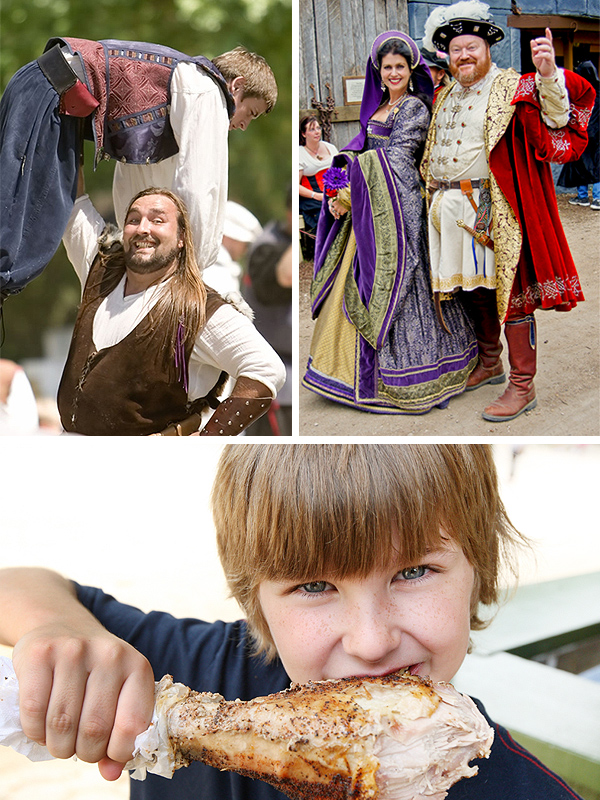Eight people are here at the Waxahachie Civic Center, hoping to join a team of more than 100 performers for the upcoming season of the Scarborough Renaissance Festival. I’m here because I wanted to look behind the curtain. I am merely an observer—or, as director Dan Grandquist will introduce me to the company later, “the Incredible Invisible Man.”
Most of the jobs these eight men and women are auditioning for offer no pay, only the opportunity to be part of the show. (Since the festival is open only on weekends, many cast members have jobs during the weekdays—or they are students and survive on the kindness of parents.) I count around the room. Including the judges, nine of the 13 men have beards or goatees. They could be a traveling family folk band. The participants are given several group improv games; the judges take notes.
“We want to see if they play well with others,” Coy Sevier, the general manager, says privately to me. Bold and rotund, sporting a sharp goatee, Sevier looks like he could play Falstaff. His Texan accent is thick and friendly. “The king isn’t the king unless everyone makes him king.”
Allen Hopps, head of character, dialect, and costuming, leans over to another judge and says, “I’m seeing plenty of bravery but no confidence.” During the next half, the judges challenge the participants with a new set of games. At the end, Grandquist warns the participants, “You are giving up the magic of how you see a Renaissance fair, but you’ll learn how the trick works.” With that, they are excused.
The next day in Waxahachie, inside a house with faux stone siding that serves as the office for Scarborough, I’m learning how the trick works. The meeting room is packed and vibrates with the excited energy of a reunion. Grandquist, paradoxically hip and nerdy with his thick-rimmed glasses and ruffled hair, stands at one end of the room. He starts the meeting and introduces me, the writer, adding, “So, please, no one drop your pants.”
Unlike what outsiders may assume, Scarborough’s staff doesn’t actually think they’re from 1533 England. They don’t wear chain mail over their airbrushed t-shirts, quote Monty Python incessantly, or get lost in World of Warcraft. They’re actors, professionals. The cast presents guerilla theater: no stage, no script, and no separation from the audience. With their help, Scarborough offers the closest thing we have to a magic kingdom in Texas. “Disney is a good thing, and that’s kinda what we’re shooting for,” Grandquist says. “We tend to think Disney is bad. And, no, Disney works for a reason. That’s what people think and dream.”
These ambitions set them apart from the usual theme park. Everyone, from the front gate to the knights, has a role to play, and even the patrons are invited to play along. Sevier interjects. “The thing we have that Disney doesn’t, Disney does not have Tinker Bell with an eye patch coming through the front gate and going, ‘Oh yeah. That’s my area. That’s where I can do what I want.’ ”
The cast discusses improvements for the new season. With the human chess match, they agree on “less yakking, more smacking.” They plan to cut the Highland Games but promise to bring it back if there’s ever a Braveheart 2. They discuss ways to make the lane fights have more of a narrative. Each seemingly spontaneous fight that breaks out at Scarborough must have a patron to champion. Also, they set more precise times and locations, so that other cast members can direct patrons to the impending brawl. The focus is on creating a safe and enjoyable experience. “We have to Disney-fy anything we do, like our House of Tarts,” Grandquist says. “We have the most family-friendly brothel ever.”
After their meeting, I wander the fair grounds. The 35-acre village is divided into three areas. Holly Field to the left, Crown Meadow directly ahead, and, walking across the bridge to the right, I enter Pecan Grove. I like this part of town. Rows of Renaissance cottages serve as the shops that will sell wooden swords, toy dragons, crystal balls, chess sets, and other Scarborough goods. Pecan Grove has the “games of skill” booths, where one can throw axes, knives, and darts. Plus, it’s next to the petting zoo. I stop in front of the home for Noobler the Tinker Gnome. His house is a hollow tree with colorful junk artfully arranged in the front yard.
I continue farther into Pecan Grove and see rusted beer cans in the grass from last season. I sneak behind some of the buildings to spy traces of modern society, a small satellite dish fixed to a wooden stairway and a refrigerator for bagged ice. A Honda Civic is parked near the Crown Stage. It is wonderfully anachronistic. When Scarborough opens on April 7, all these inconsistencies hide behind the curtain.
Scarborough patrons are a divided bunch. Some people go for the beer, and others want to see fire and stage violence. Some people will see grown men dressed in plated armor as being inherently dorky—akin to the adolescent mouth-breathers who played Dungeons & Dragons during recess. Some buy into the illusion. I focus on men wielding broad swords, Sholo the Nubian, Daniel Duke of Danger (my life coach), Christopher the Insulter, Twig the Fairy, women in corsets and plunging necklines. In truth, Scarborough is no Disneyland. After all, the “It’s a Small World” ride doesn’t have a fully operational cannon that’s fired throughout the day.
For the patrons, the day ends with a joust and a pub sing. For the people who work Scarborough, the day doesn’t end there. Many of the 2,000 vendors, cast, stage performers, and other fair workers live at a nearby campsite during the eight weeks that Scarborough is open. Some work the circuit, moving from one Renaissance fair to another across the country. Many of them exist near the poverty level and live off food stamps. I talked with Tony Hawkins about the campsite. Hawkins was in the cast in 1995 and 1996 as a member of the dance
group and a puppeteer.
“There are all types,” he says. “You know, it’s a campground. People hang out there, and you can do whatever.” Hawkins pauses to choose his words carefully. “There’s this guy named Dan [not Grandquist] that was not the sort of person who should be wearing a thong, but there’s an area out there, a river where they go and wash in, bathe in. There is a comfort with nudity in certain aspects, in certain areas.”
I think about Twig the Fairy and my imagination wanders. Despite the long days, according to Hawkins, the nights are also long. “On the
weekends, it goes on pretty late, because that’s your social time,” he says. Hawkins misses his days working the fair. “You don’t want your daughter doing Scarborough, but you should definitely take the opportunity to do it if you’re 18 or 19, and not your daughter.”
He smiles as if to tell me I will never fully know what’s behind the curtain. There is a Scarborough for the t-shirt and jeans patrons. It’s a fun place. But there’s also a Scarborough for those who make it work. I prod for more, but I’m the Invisible Man. So, please, no one drop your pants.
The fair is held every weekend (plus Memorial Day) from April 7 to May 28. See srfestival.com for more info. Write to [email protected].







